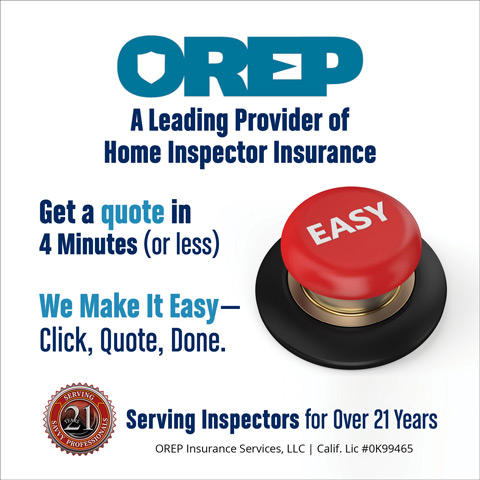 | > E&O/GL Insurance for Home Inspectors Competitive Rates, Broad Coverage, Free Risk Management, online inspection support for tough questions, discounts on education and more… Professional Coverage, Competitive Pricing Shop OREP today! |
How to Make More Money as a Home Inspector
by Lauren Kelly, HomeGauge
One of the biggest reasons people choose to become home inspectors is to control their destinies. Starting your own home inspection business gives you the power to fully manage your own schedule, and at the end of the day, you answer to yourself—not a general contractor, municipal building inspector, or corporate overlord.
On the other hand, all that freedom comes with a price. It’s all on you to make your company grow. That can be tricky when you’re offering a service. There are only so many hours in the day, right? At some point, doubling your workload to earn more just isn’t going to be feasible.
Fortunately, there are several things you can do to streamline your business practices and add some out-of-the-box ideas to boost your income, while still managing to have some free time to live the life you want. Try these ideas to increase your home inspection business profits.
1. Audit Your Costs and Cut Where You Can
If you’re the only one on your payroll, it’s easy to assume that you don’t really have any business costs. But every business has some cost of entry, so it’s a good practice to make sure you know exactly where your money is going.
To get a handle on this, it’s time to make a list. If you already save receipts for your business expenses for tax time, pull out the most recent years’ worth. If not, here are some common home inspection business costs to get you started:
• Office Space: Rent/mortgage, utility costs, insurance, etc.
• Transportation: Vehicle loan, fuel, mileage, insurance, registration,
maintenance
• Equipment: Annual equipment costs and maintenance, including items that
need to be replaced regularly
• Marketing: Advertising costs, including your website, branded handouts—like
business cards, brochures, and magnets, plus any other gifts you give to
Realtors and clients
• Office Supplies: Paper, printer ink, computer costs, staples, paper clips,
pens—all the little things you need
• Other Business Expenses: Uniforms/branded clothing, business insurance,
home inspection software, and any other specialty item you use for your
inspection business
Once you have your list, review it carefully. Is there anything you don’t use or that hasn’t been effective? If those donuts you take to real estate agencies don’t lead to more business, see what happens if you cut that expense for a bit.
Next, review your expenses for places where you can save. Maybe you can shop around for a better deal on insurance, utilities, or office supplies. You might also consider asking for a discount from a supplier if you’ve been a long-term customer—you never know until you ask!
While cutting your expenses may seem like small potatoes, it’s an important business practice to ensure that you are operating as efficiently as you can. The old saying about a penny saved being a penny earned really is true!
2. Strategically Raise Prices
Raising prices can be scary because it’s easy to assume that your current clients will run away screaming at the very thought. Home inspectors have an advantage in this department because your direct clients—typically homebuyers—aren’t coming to you for repeat business very often. They won’t know if you raised your rates over last year’s prices unless they buy a house every year, which is pretty unlikely!
What they will notice is how your prices compare to your competitors. This is where pricing strategy comes into play. You’ll want to spend some time researching what other local home inspectors are charging for their services.
To do this, make a list of the other home inspectors in your area. If you live in a sparsely populated area, you can include all of the inspectors that pop-up on a Google search. If you live where there are loads of other inspectors, you may have to limit your list to just the ones that offer the same services you do, or who target the same types of clients. Just do your best to get a broad view of the market in your area.
As you research, it’s important to get an apples-to-apples look at pricing, so dig into what each inspector is offering for their rate. Are they adding any extras in, like a free do-it-yourself radon test kit? Do they add value with new technology, like drone cameras? When you make a list, be careful to detail what comes with the price.
Once you’ve got some info, it’s time to analyze. Find the average cost for a baseline, and consider where you stack up compared to that number. If you’re below average, consider raising your prices to meet the average for your area, which is a perfectly reasonable change to make.
If you’re already near the average or above, you may still be able to raise your rates if you find a way to add value. Value-based pricing means zeroing in on something that differentiates you, deciding what that’s worth, and raising your price accordingly. For example, if no one in your area has that drone for roof inspections, and you add roof photos to your inspection report, you’re adding value. Is it worth an extra $50? That’s up to you—just be sure to highlight that special touch on your website and in all your materials to justify the higher rate.
(story continues below)
(story continues)
3. Add Ancillary Services your Customers Crave
If you’re looking for ways to add value, consider offering some additional services that your clients are likely to need. For example, you may come across common issues during an inspection that require further probing beyond the standard inspection. Instead of sending your clients elsewhere for those services, offer them yourself!
There are many ancillary services that Home Inspectors can consider. Some of the most popular include:
• Asbestos testing
• Sewer scope inspections
• Indoor air quality testing
• Water quality testing
• Pool and spa inspections
• Radon testing
• Home energy audits
• Lead paint testing
• Mold inspections
• Wood Destroying Organism inspections
To decide what will bring the most value to your business, consider the common issues in your region. For example, mold will likely be an issue in damp regions or those areas prone to coastal flooding and storm surges. Meanwhile, lead paint testing is needed in areas with an older housing stock.
Talking to your contacts in real estate offices is also a great way to get a sense of what their clients ask for so you can meet those needs. You can also consider asking contacts and clients to complete a quick survey to get a sense of how to expand your business.
4. Streamline your Practices
You can’t add hours to the day, but you can work to be more efficient at what you do. If you’ve been running yourself ragged, take some time to figure out exactly where you’re spinning your wheels.
For example, how smooth is your scheduling? If you’re spending a lot of time playing phone tag with customers to get their inspections scheduled, it’s time to consider an online scheduling program that makes it easy for clients to click and book—all to populate your calendar automatically.
You might also consider scheduling in a regional way if you cover a large geographic area. For example, if you can find a way to keep one county’s inspections on Mondays and another’s on Wednesdays, you can save yourself some commuting time in between jobs.
Likewise, the right tools will help you write up your inspection reports faster. Great home inspection software keeps you organized and makes it easy to turn your notes into a polished report that you can submit electronically. If you can shave hours off of your paperwork time, you’ve given yourself more opportunities to get out in the field with paying clients.
5. Hire Extra Help
If you’ve done all of the above and still want to grow, it’s probably time to consider bringing on an extra set of hands to expand the number of clients you can see each week. This is a complex business decision, as you’ll have to weigh the costs of wages, benefits, and training with the additional income you expect to bring in from hiring. At some point, hiring is the only way forward if you want to take on more clients than you can serve on your own.
Another option is to consider a partnership or co-op arrangement, where you share the costs of doing business with other Inspectors and come up with an equitable way to share profits. Depending on your model, that could be an equal division of profits or a system in which each inspector keeps the fee for the clients they bring to the table.
About the Author:
Lauren Kelley is the Marketing and Business Development Manager at HomeGauge. She focuses on driving inspector success to new heights. Having vast experience working with new and experienced inspection businesses of all sizes, HomeGauge has provided home inspection software and business solutions for over 20 years. Whether you are new to the industry, or looking to scale, HomeGauge has everything inspectors need. Visit HomeGauge online at: www.homegauge.com/orep.
OREP Insurance Services, LLC. Calif. License #0K99465



